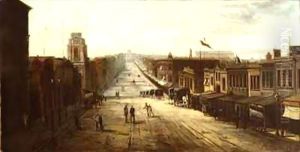Charles Blanchard Paintings
Charles Émile Blanchard was a French artist known for his contributions to painting, particularly in the genres of landscape and portraiture. Born on March 31, 1856, in Poinçon-lès-Larrey, France, Blanchard showed an early interest in art, which led him to pursue formal education in the field. He studied at the École des Beaux-Arts in Paris, where he was under the tutelage of renowned artists such as Alexandre Cabanel and William-Adolphe Bouguereau. Blanchard's classical training provided him with a strong foundation in the technical aspects of painting, which he would later apply to his own unique style.
Blanchard's work is characterized by its meticulous attention to detail, vibrant color palette, and the ability to capture the essence of his subjects. His landscapes often depict serene, idyllic settings that seem untouched by the industrialization of the era, offering a nostalgic view of rural France. Meanwhile, his portraits are noted for their psychological depth and the way they capture the personality and spirit of the individuals portrayed. Throughout his career, Blanchard exhibited his work at various salons and galleries, gaining recognition and accolades for his contributions to French art.
Despite his success, Charles Émile Blanchard remains a somewhat lesser-known figure in the broader context of 19th-century French painting, often overshadowed by his contemporaries. However, his work continues to be appreciated by art historians and collectors for its beauty and craftsmanship. Blanchard's paintings are held in several private collections and museums, where they continue to be studied and admired. He passed away on February 10, 1939, leaving behind a legacy of artwork that continues to inspire and captivate audiences. Blanchard's dedication to his craft and his ability to convey the beauty of the natural world and the human condition have secured his place in the annals of French art history.

